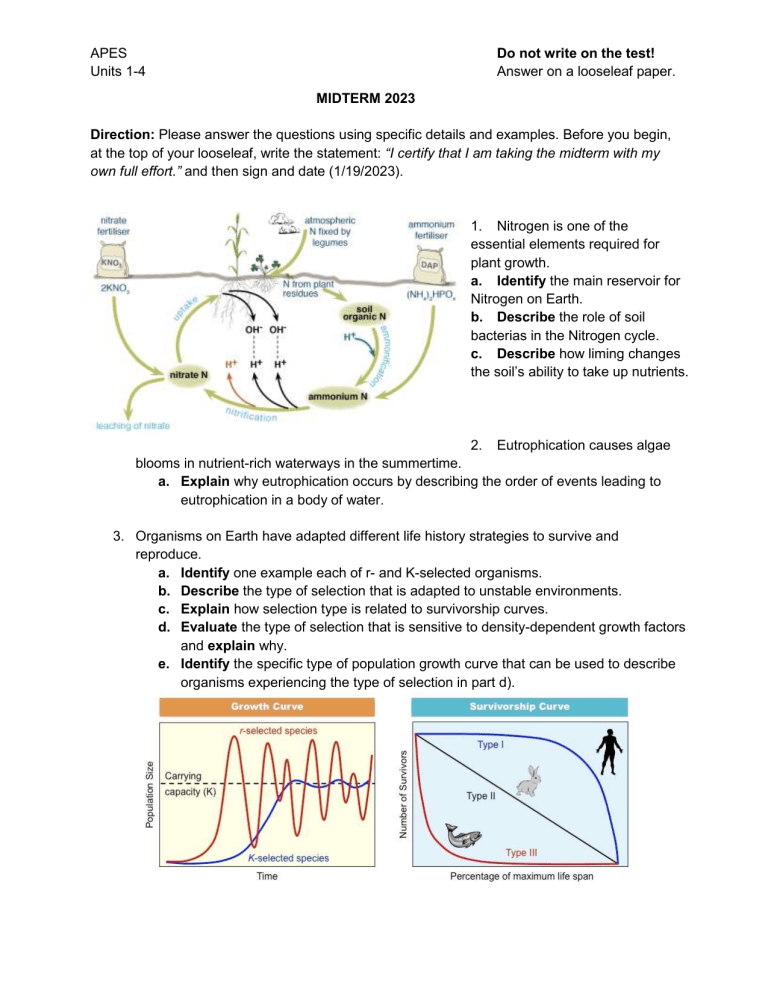
APES Units 1-4 Do not write on the test! Answer on a looseleaf paper. MIDTERM 2023 Direction: Please answer the questions using specific details and examples. Before you begin, at the top of your looseleaf, write the statement: “I certify that I am taking the midterm with my own full effort.” and then sign and date (1/19/2023). 1. Nitrogen is one of the essential elements required for plant growth. a. Identify the main reservoir for Nitrogen on Earth. b. Describe the role of soil bacterias in the Nitrogen cycle. c. Describe how liming changes the soil’s ability to take up nutrients. 2. Eutrophication causes algae blooms in nutrient-rich waterways in the summertime. a. Explain why eutrophication occurs by describing the order of events leading to eutrophication in a body of water. 3. Organisms on Earth have adapted different life history strategies to survive and reproduce. a. Identify one example each of r- and K-selected organisms. b. Describe the type of selection that is adapted to unstable environments. c. Explain how selection type is related to survivorship curves. d. Evaluate the type of selection that is sensitive to density-dependent growth factors and explain why. e. Identify the specific type of population growth curve that can be used to describe organisms experiencing the type of selection in part d). APES Units 1-4 Do not write on the test! Answer on a looseleaf paper. 4. Wetlands are one of the most significant biomes found on Earth. a. Identify ONE regulating and ONE provisioning ecosystem service of wetlands. b. Explain why wetlands have a high net primary productivity. c. Identify and describe TWO changes to wetland ecosystem services if sea level were to rise by six feet in the next century. 5. All organisms evolved to fulfill specific niches in their environments. The seastar Pisaster is known as a keystone species in its tidal habitat. a. Define the term keystone species. b. Describe why the seastar Pisaster is considered a keystone species in its habitat. Be specific about the seastar’s niche. c. The removal of a keystone species causes a trophic cascade. Describe an example of a trophic cascade besides the Pisaster; be specific. 6. After a natural or anthropogenic disturbance, plants recolonize an area and the new ecosystem matures over time in what ecologists call ecological succession. a. Compare and contrast primary and secondary ecological succession. b. Explain why moss and lichen are the pioneer species in a new area. c. Explain why pines are the first tree species to colonize a new area. d. Evaluate the end results of primary ecological succession in a desert versus a deciduous forest biome. 7. Soil is a living entity. Soil formation is a slow process and ultimately limited by the rate of weathering of bedrock. a. Describe the O, A, and E horizons that you’d find in a forest soil such as Alfisol. b. Compare and contrast the O horizon in a Mollisol versus an Aridisol. c. Identify TWO distinguishing features of deeply weathered tropical soils. APES Units 1-4 Do not write on the test! Answer on a looseleaf paper. d. Explain how an Entisol might change in a stable environment in a warm and moist climate, over the course of several thousand years. 8. Agricultural stakeholders closely monitor the physical and chemical properties of soil in their bid to maximize their productivity. a. Identify the correct name for a soil consisting of 50% sand, 10% clay, and 40% silt. b. Identify a change to the particle composition of the soil in a) that would result in a soil with a higher Cation Exchange Capacity. c. Identify a change to the particle composition of the soil in a) that would reduce permeability. d. Identify ONE advantage and ONE disadvantage of plowing the soil for the longterm health and productivity of the soil. e. Due to acid deposition, the pH of the soil in part a) has decreased from 7 to 5.5. Explain how this change in pH has affected the soil’s ability to produce a maximum crop yield. f. Identify TWO causes of soil erosion and then Identify ONE potential solution to the problem of soil erosion based on one of the causes you listed. g. Identify the cause for acid deposition in soil and specify the origin and formation of these acids on Earth. 9. Population pyramids offer key insights into human demographics. Please examine the pyramid below and answer the questions that follow. a. The population of this country is around 96 million people. If the population were to grow at a rate of 7% a year, how many years does it take this population to double? b. This country is in Stage 3 of the Demographic Transition Model. Briefly describe this country’s birth and death rates, and any other socioeconomic characteristics of a Stage 3 country. c. Identify THREE ways that the government can incentivize young couples to have more children. APES Units 1-4 Do not write on the test! Answer on a looseleaf paper. d. Identify THREE possible reasons why the birth rate may be dropping in a developing country. 10. Climate change is causing far-reached ecosystem changes, including soil degradation in many of the world’s biomes. Describe TWO ways that climate change can degrade soil. Be as specific as you can. BONUS 11. Describe THREE human activities related to the rapidly growing world population that are having an impact on Earth’s biodiversity. Be as specific as you can.



